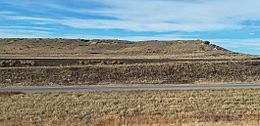Fox Hills Formation facts for kids
Quick facts for kids Fox Hills FormationStratigraphic range: Late Cretaceous |
|
|---|---|

A ridge capped by a sandstone bed of the Fox Hills Formation west of Limon, Colorado
|
|
| Type | Geological formation |
| Unit of | Montana Group (MT, ND) |
| Sub-units | Fairpoint member (SD), Trail City member (ND, SD), Timber Lake (ND, SD), Lincoln member (CO), etc. |
| Underlies | Lance (WY)/Hell Creek (MT) Laramie Formation (CO) |
| Overlies | Pierre (USA)/Bearpaw (CAN) Lewis Shale (WY, MT) |
| Thickness | 75-225 feet |
| Lithology | |
| Primary | Sandstone |
| Other | Shale |
| Location | |
| Region | Alberta, Colorado, Montana, North Dakota, South Dakota and Wyoming |
| Country | United States/Canada |
| Type section | |
| Named for | Fox Hills between Cheyenne and Moreau Rivers, South Dakota |
| Named by | Meek and Hayden |
| Year defined | 1862 |
The Fox Hills Formation is a special layer of rock found in the northwestern Great Plains of North America. It stretches all the way from Alberta, Canada, in the north, down to Colorado in the United States. This rock formation was created during the Cretaceous period, a very long time ago.
Geologists study rock formations like the Fox Hills to learn about Earth's past. They can find clues about ancient environments and the creatures that lived there.
Contents
What Is the Fox Hills Formation?
The Fox Hills Formation is mostly made of yellow to gray sandstone. It also has layers of shale mixed in. These rocks tell us that the area was once covered by a large, shallow sea. This sea is known as the Western Interior Seaway.
How the Rocks Formed
Imagine a huge inland sea that once covered the middle of North America. The Fox Hills Formation formed as this sea slowly pulled back. It left behind sandy areas like barrier islands and beaches. Over millions of years, these sands and muds turned into the sandstone and shale we see today. This process is called a regressive sequence. It means the sea was retreating.
Where You Can Find It
- In the eastern parts of its range, the Fox Hills Formation sits on top of a rock layer called the Pierre Shale in the U.S.
- In Canada, it sits on top of the Bearpaw Formation, which is similar to the Pierre Shale.
- Further west, in Montana and Wyoming, it lies on top of the Lewis Shale.
Above the Fox Hills Formation, you'll find other rock layers.
- In Colorado, it's covered by the Laramie Formation.
- In Wyoming, it's covered by the Lance Formation.
- In Montana, it's covered by the Hell Creek Formation. These top layers were formed on land, not in the sea.
Ancient Life in the Fox Hills Formation
The Fox Hills Formation is famous for the amazing fossils found within its rocks. These fossils give us a peek into the ancient world.
Dinosaur Discoveries
Scientists have found fossil remains of dinosaurs in the Fox Hills Formation. This includes fearsome meat-eaters like tyrannosaurs. Finding dinosaur fossils here is special because the formation was mostly formed in a marine (sea) environment. This means the dinosaur remains might have been washed into the sea after the animals died on land nearby.
Marine Reptile Fossils
Since the Fox Hills Formation was formed in a sea, it's also a great place to find fossils of large marine reptiles. These include giant swimming lizards called mosasaurs. Mosasaurs were powerful predators that lived in the ancient seaway. Their fossils help us understand the marine life of the Late Cretaceous period.

